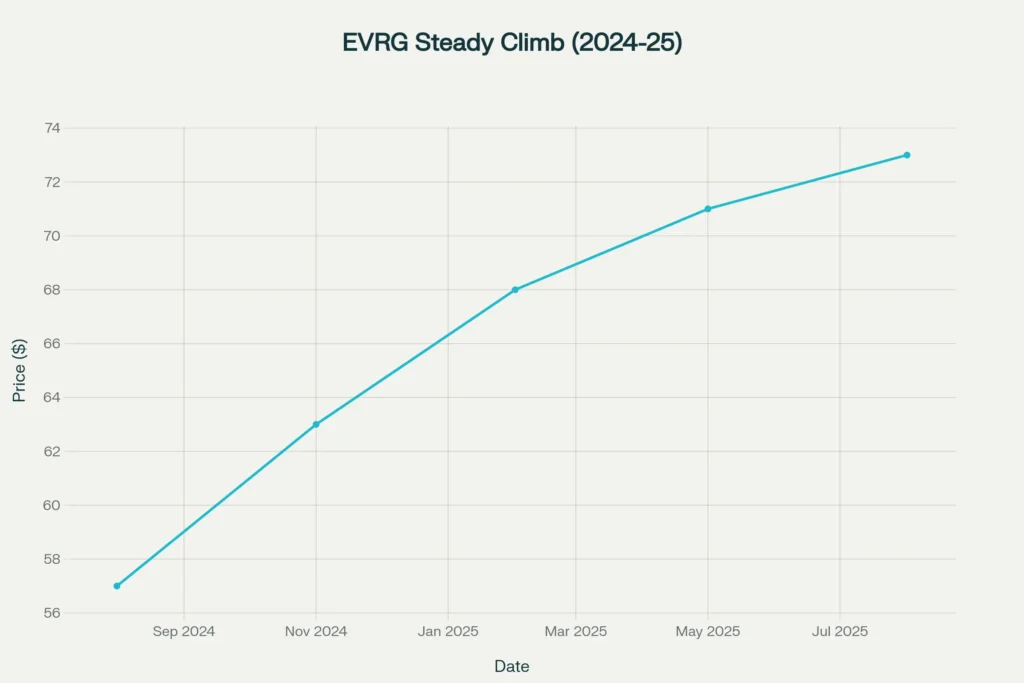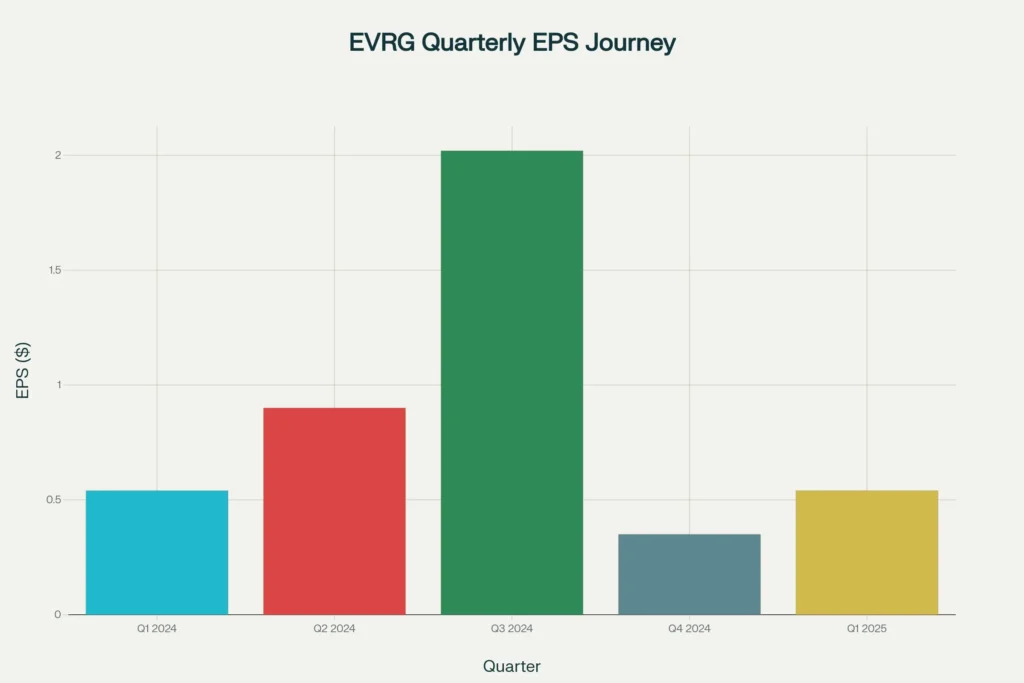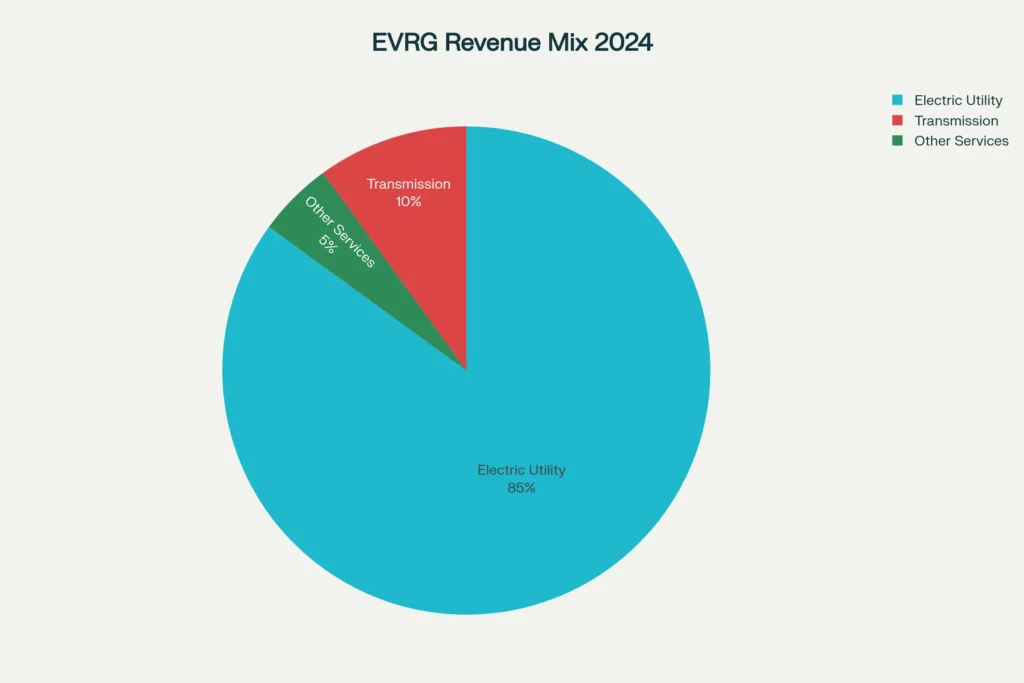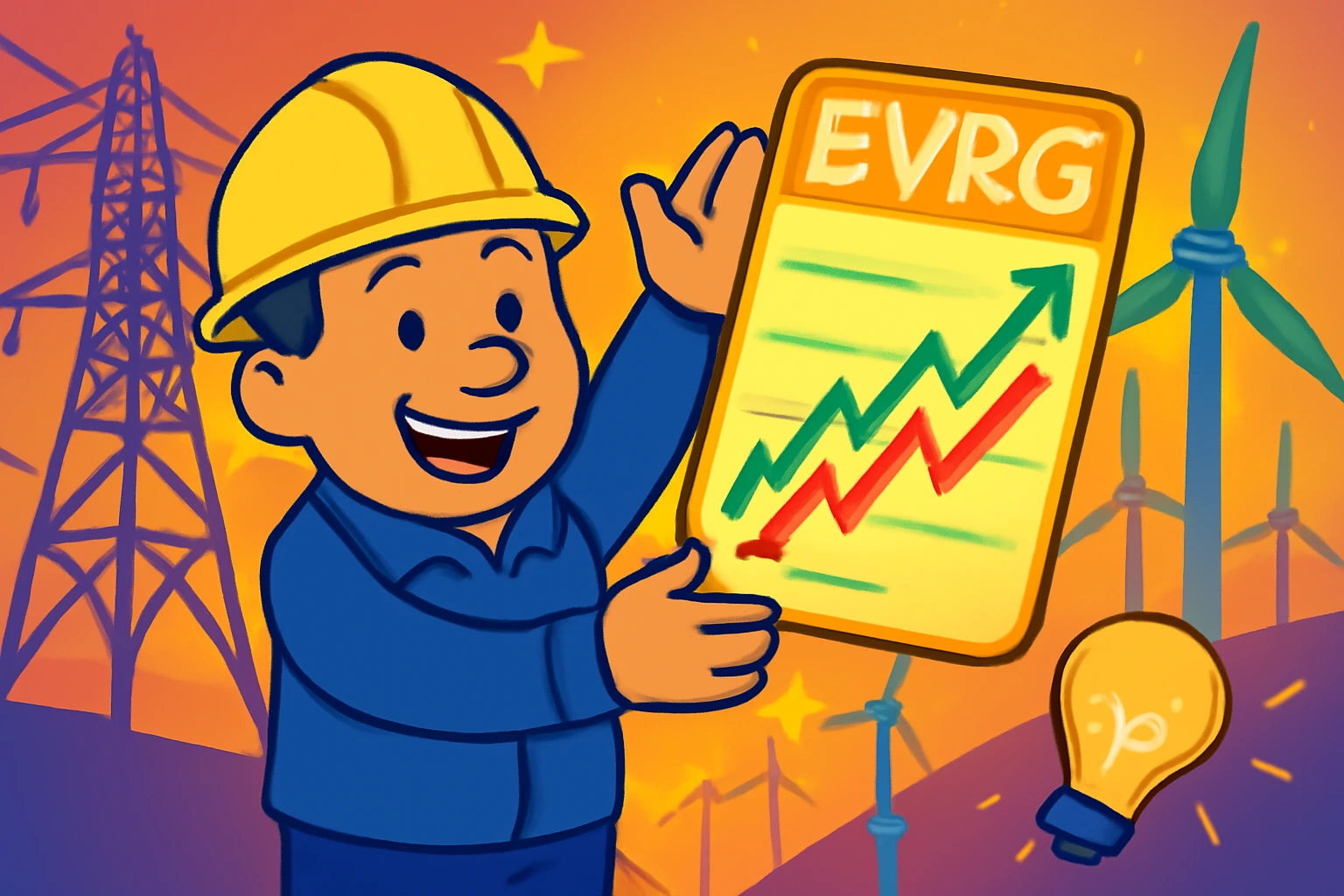Utility investing often feels boring, right? However, smart investors know one secret. Furthermore, some utility companies offer steady growth plus reliable dividends. Moreover, EVERGY might surprise you with its potential.

Meet the Powerhouse Behind EVERGY
First, EVERGY serves over 1.6 million customers across Kansas and Missouri. Additionally, the company generates, transmits, and distributes electricity to homes and businesses. Furthermore, this regulated utility model provides predictable cash flows year after year.
Moreover, EVRG emerged from the merger of Westar Energy and Kansas City Power & Light in 2018. Therefore, the combined entity became one of the largest electric utilities in the Midwest. Additionally, this strategic combination created significant cost savings and operational efficiencies.
Currently, EVRG trades around $73 per share with a market cap of approximately $17 billion. Furthermore, the stock has shown steady appreciation over the past year. Additionally, the company maintains a solid dividend yield that attracts income-focused investors.

EVERGY Financial Performance Deep Dive
The numbers tell an interesting story about EVRG’s financial health. First, total revenue reached $5.9 billion in 2024, representing a 6% increase from the previous year. Moreover, this growth came despite challenging economic conditions affecting many sectors.
However, net income faced some headwinds in recent quarters. Specifically, full-year 2024 earnings per share came in at $3.41, slightly below analyst expectations of $3.45. Nevertheless, the company maintained strong operational cash flow throughout the period.
Furthermore, EVERGY’s quarterly earnings show typical seasonal patterns common in utility companies. For instance, summer quarters typically generate higher earnings due to increased air conditioning demand. Meanwhile, winter quarters may show lower results depending on heating requirements.

EVERGY Business Model Breakdown
The beauty of EVERGY lies in its diversified revenue streams within the utility sector. First, electric utility operations account for approximately 85% of total revenue. Additionally, transmission services contribute around 10% of earnings. Moreover, other services make up the remaining 5% of revenue.

This revenue mix provides stability during economic downturns. Furthermore, the regulated nature of the business allows for predictable rate increases over time. Additionally, EVERGY operates in a framework that typically guarantees reasonable returns on invested capital.
Moreover, the company serves both residential and commercial customers. Specifically, residential customers account for about 50% of electricity sales. Meanwhile, commercial and industrial customers contribute the remaining portion. Therefore, this balanced customer base reduces concentration risk significantly.
The Renewable Energy Transition
EVERGY is actively participating in the clean energy transition sweeping across America. First, the company has committed to achieving net-zero carbon emissions by 2045. Additionally, significant investments in wind and solar generation support this ambitious goal.

Currently, renewable energy sources comprise approximately 40% of EVRG’s generation portfolio. Furthermore, the company plans to add more wind capacity over the next five years. Additionally, these investments should drive rate base growth and earnings expansion.
Moreover, regulatory support for clean energy creates favorable conditions for utility companies investing in renewables. Therefore, EVRG’s proactive approach positions it well for future opportunities. Additionally, customers increasingly demand cleaner energy sources, making these investments strategically sound.
Furthermore, the Infrastructure Investment and Jobs Act provides additional support for grid modernization projects. Consequently, EVRG can access federal funding for certain infrastructure improvements. Therefore, this reduces the financial burden of necessary upgrades while maintaining system reliability.
EVRG Dividend Analysis
Income investors particularly appreciate EVRG’s dividend policy. Currently, the company pays a quarterly dividend of $0.67 per share, yielding approximately 3.7%. Moreover, this yield compares favorably to other utility stocks and significantly exceeds broad market averages.
Furthermore, EVRG has maintained consistent dividend payments since the 2018 merger. Additionally, the company targets a payout ratio between 65% and 75% of earnings. Therefore, this conservative approach leaves room for dividend growth while maintaining financial flexibility.
Moreover, the dividend coverage ratio remains healthy at current earnings levels. Specifically, the company generated sufficient cash flow to cover dividend payments with room to spare. Therefore, income-focused investors can feel confident about payment sustainability.
Additionally, EVRG’s management has indicated intentions to grow the dividend in line with earnings growth. Furthermore, the company’s five-year plan suggests annual dividend increases of 5% to 7%. Consequently, long-term investors could benefit from compounding dividend growth over time.
Fundamental Analysis of EVRG Stock
Several key metrics help evaluate EVRG’s fundamental strength. First, the price-to-earnings ratio currently sits around 21.4, which appears reasonable for a quality utility company. Additionally, this valuation compares favorably to historical averages and peer companies.
Furthermore, EVRG maintains a relatively conservative debt-to-equity ratio of approximately 1.3. Moreover, this level of leverage is typical for utility companies that require significant capital investments. Additionally, the company’s credit rating reflects investment-grade status from major rating agencies.
Moreover, return on equity has averaged around 10% over the past five years. Therefore, management has demonstrated consistent ability to generate returns for shareholders. Additionally, this metric compares well to industry benchmarks and suggests efficient capital allocation.
Furthermore, the company’s allowed rate of return in Kansas and Missouri provides a framework for earnings growth. Specifically, regulators typically allow utilities to earn returns between 9% and 11% on invested capital. Therefore, rate base growth translates directly into earnings expansion over time.
Growth Drivers for EVRG
Several factors could drive future growth for EVRG shareholders. First, the company has outlined a five-year capital investment plan totaling approximately $11 billion. Moreover, these investments focus on grid modernization, renewable energy, and system reliability improvements.
Additionally, customer growth in EVRG’s service territory provides organic expansion opportunities. Furthermore, economic development initiatives in Kansas and Missouri attract new businesses to the region. Therefore, increased electricity demand should support long-term revenue growth.
Moreover, regulatory mechanisms allow EVRG to recover prudent investments through rate adjustments. Specifically, the company can file for rate increases to reflect higher invested capital. Therefore, shareholders benefit from earnings growth tied to infrastructure investments.
Furthermore, technology improvements in grid operations create opportunities for cost savings and efficiency gains. Additionally, smart grid investments reduce operational expenses while improving service reliability. Consequently, these improvements should enhance profit margins over time.
Risk Factors to Consider
Despite its strengths, EVRG faces several risk factors that investors should understand. First, regulatory changes could impact allowed returns or recovery of certain investments. Additionally, political pressure for lower utility rates might constrain earnings growth in some periods.
Moreover, weather patterns significantly affect EVRG’s quarterly results. Specifically, mild summers reduce air conditioning demand while warm winters decrease heating requirements. Therefore, investors should expect some volatility in quarterly earnings due to weather variations.
Furthermore, interest rate changes impact EVRG’s financing costs and dividend attractiveness relative to bonds. Additionally, rising rates increase the cost of new debt while making dividend yields less attractive to income investors. Consequently, interest rate trends represent an important consideration for potential shareholders.
Additionally, environmental regulations continue evolving, potentially requiring additional compliance investments. Moreover, the transition away from coal generation involves significant capital expenditures. Therefore, execution risks exist around the timing and cost of plant retirements and replacements.
EVRG Investment Strategy
For investors considering EVRG, several strategies might prove effective. First, dollar-cost averaging allows gradual position building while smoothing out price volatility. Additionally, this approach works particularly well for dividend-paying stocks like utilities.
Moreover, reinvesting dividends can significantly enhance long-term returns through compounding. Furthermore, many brokers offer automatic dividend reinvestment plans at no additional cost. Therefore, patient investors can build substantial positions over time through this simple strategy.
Additionally, utility stocks often perform well during periods of market uncertainty. Furthermore, their defensive characteristics make them attractive during economic downturns. Therefore, EVRG might serve as a portfolio stabilizer during volatile market conditions.
However, investors should maintain reasonable position sizes within overall portfolio allocation. Specifically, most financial advisors recommend limiting utility exposure to 5% to 10% of total investments. Therefore, diversification across sectors remains important for managing overall portfolio risk.
The Bottom Line on EVRG
EVRG represents a solid utility investment with attractive dividend yield and steady growth prospects. Furthermore, the company’s regulated business model provides predictable cash flows and earnings visibility. Additionally, strategic investments in renewable energy position EVRG well for the future.
However, like all investments, EVRG carries risks that require careful consideration. Moreover, utility stocks may underperform during periods of strong economic growth when investors favor higher-growth sectors. Therefore, EVRG works best as part of a diversified investment strategy.
Furthermore, the combination of current income and modest capital appreciation makes EVRG suitable for conservative investors seeking steady returns. Additionally, the company’s commitment to dividend growth adds appeal for income-focused portfolios.
Ultimately, EVRG offers a compelling investment proposition for investors seeking exposure to essential services with reliable dividend income. However, individual circumstances and investment goals should guide final investment decisions. Therefore, thorough research and professional consultation remain important before making any investment commitments.
You Might also find this post insightful – https://bosslevelfinance.com/shocking-truth-why-qqq-could-transform-your-portfolio
Remember, this analysis provides educational information only. We strongly encourage conducting your own research and consulting with qualified financial advisors before making investment decisions. Market conditions change rapidly, and past performance never guarantees future results.
Sources:
- https://stockanalysis.com/stocks/evrg/
- https://finance.yahoo.com/quote/EVRG/
- https://public.com/stocks/evrg/earnings
- https://www.nasdaq.com/articles/evergy-q4-earnings-miss-estimates-revenues-rise-y-y
- https://www.koyfin.com/company/evrg/dividends/
- https://macrotrends.net/stocks/charts/EVRG/evergy/financial-statements
- https://www.gurufocus.com/term/payout/EVRG
- https://www.tipranks.com/news/company-announcements/evergy-announces-q1-2025-financial-results-and-dividend
- https://simplywall.st/stocks/us/utilities/nasdaq-evrg/evergy/dividend
- https://finance.yahoo.com/quote/EVRG/key-statistics/
- https://www.nasdaq.com/market-activity/stocks/evrg/dividend-history
- https://stockanalysis.com/stocks/evrg/financials/ratios/





Pingback: Why Walmart Could Supercharge Your Long-Term Wealth